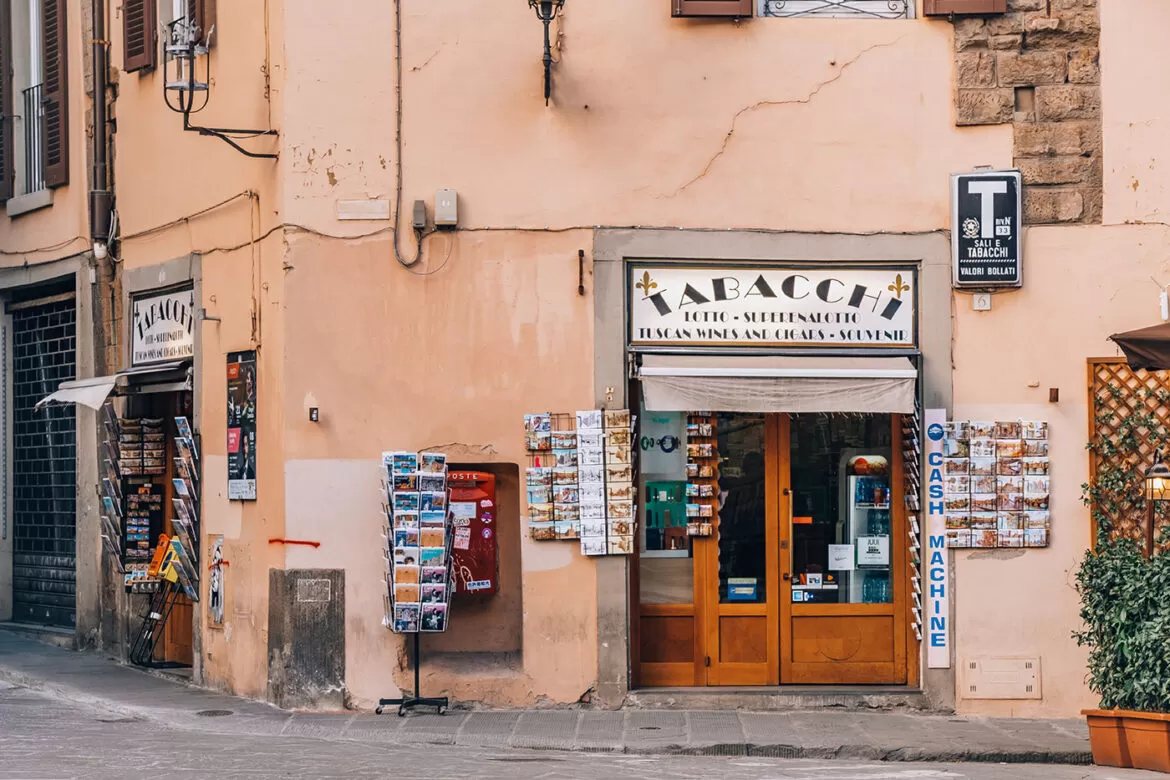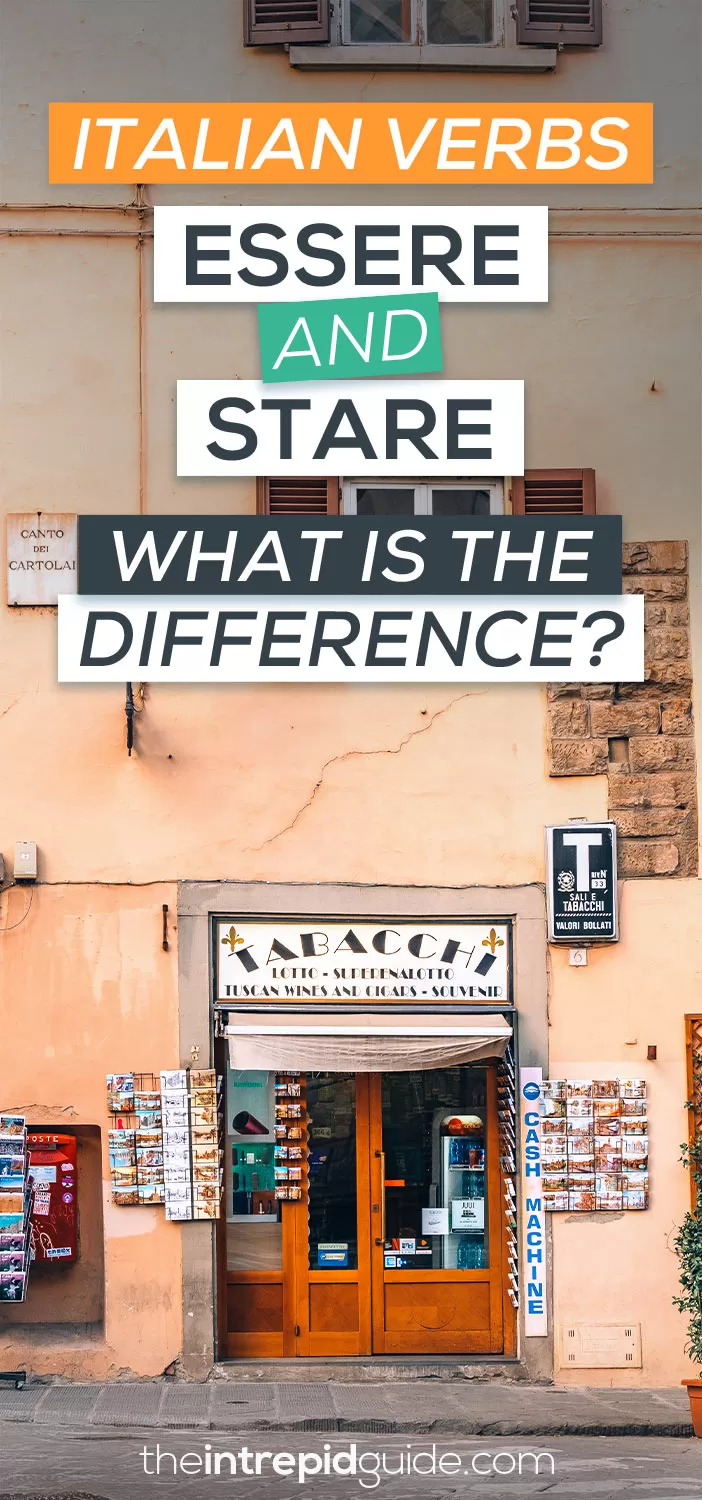Essere o… stare? Questo è il dilemma! (‘To be’ or… ‘to stay’? That is the question!)
Ok, this isn’t exactly what Shakespeare meant, but, as a student of Italian, I’m sure this question popped into your mind quite a few times! As a beginner, you’re taught that essere is the equivalent of the English ‘to be’, whereas stare means ‘to stay’ in most cases.
But then why can we say…
- Dov’è il tabaccaio? – Sta dietro l’angolo (Where is the tabacconist? – It’s around the corner)
Well, unfortunately, these two verbs are much more complex than you might think! But don’t worry. In this guide, I’ll explain the differences between these two verbs, which can easily be confused, especially because they have the same past participle: stato.
Sono stato/a… Does it mean ‘I was’ or ‘I stayed’? Or both? Or neither? In some cases, these two verbs have similar uses but with different nuances, while there are specific contexts in which only one of these verbs makes sense. Let’s take a look at when you should use essere and when you should use stare in Italian.
Iniziamo! (Let’s begin!)
What is the difference between ESSERE and STARE?
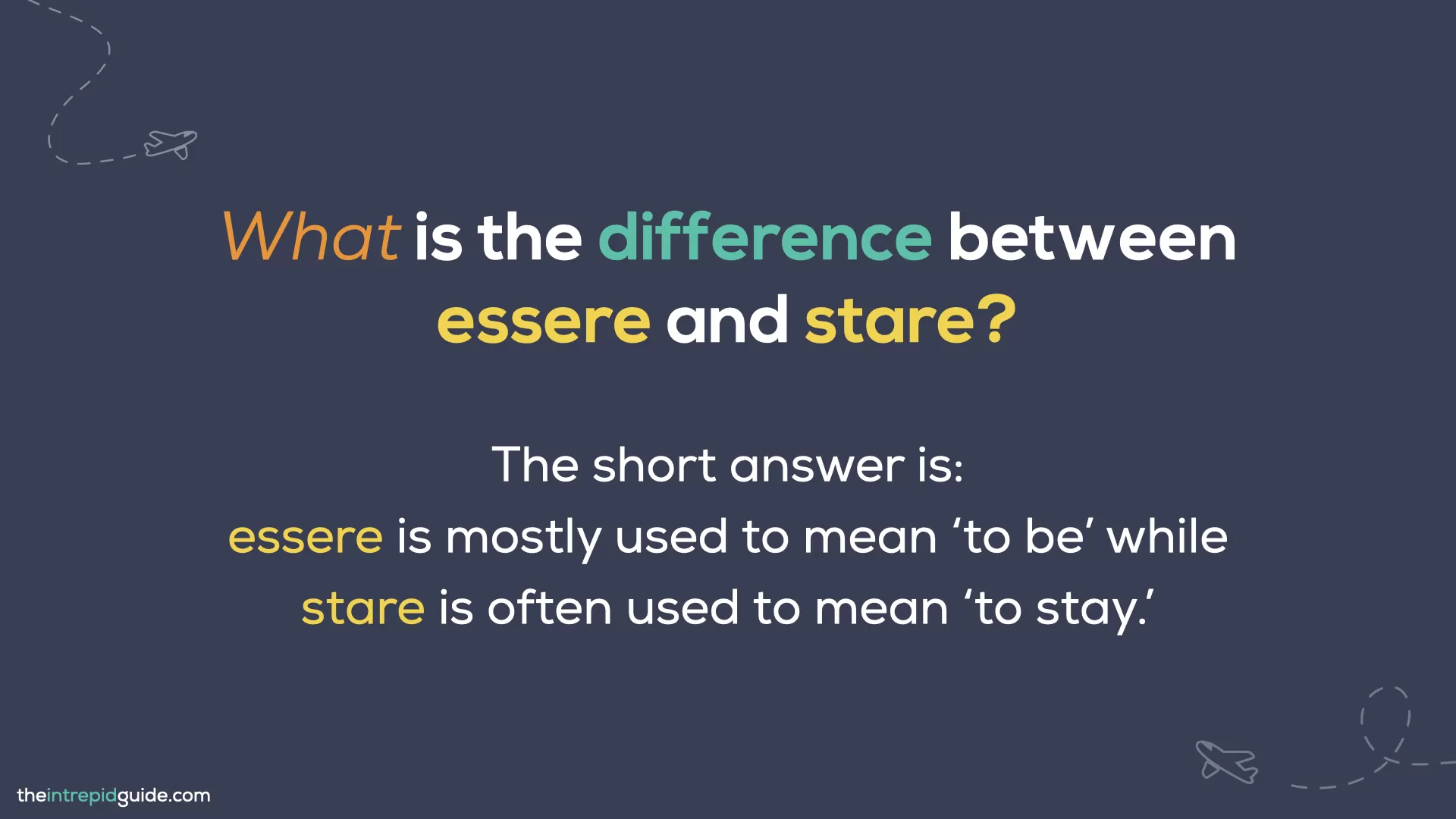 The short answer is: essere is mostly used to mean ‘to be’; while stare is often used to mean ‘stay.’ But there are several nuances and other meanings we use these verbs for. Let’s take a look!
The short answer is: essere is mostly used to mean ‘to be’; while stare is often used to mean ‘stay.’ But there are several nuances and other meanings we use these verbs for. Let’s take a look!
*Tip: For a list of common Italian verbs, get my free guide here. It includes a FREE PDF cheat sheet you can download and practice with.
The Italian verb ESSERE
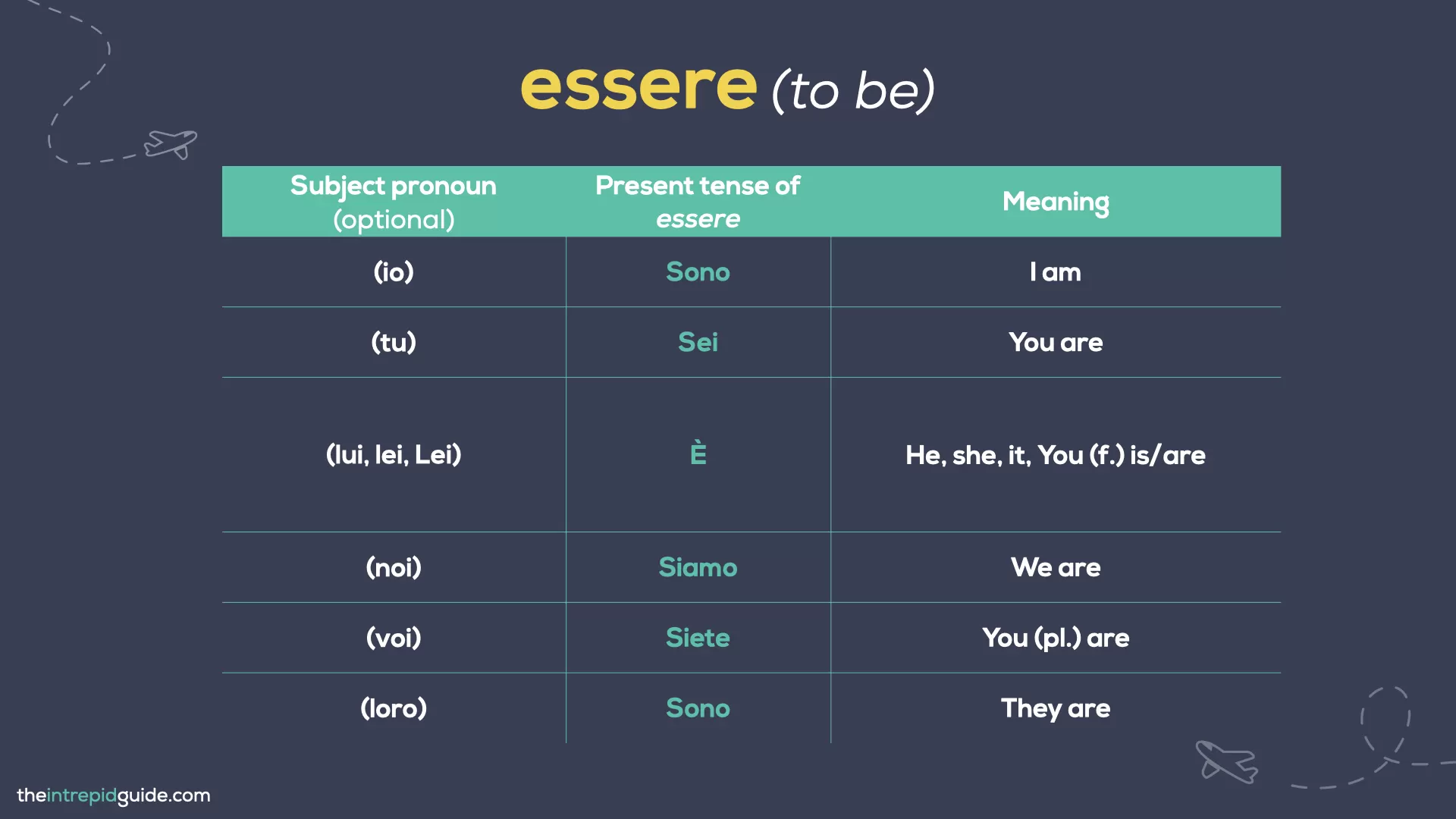 Let’s take a look at all three cases where the verb essere is used. But first, let’s see how it is conjugated in the present tense. Remember that essere, together with avere, doesn’t fall into any of the -are, -ere, -ire conjugation groups, but has its own special (and irregular) conjugation!
Let’s take a look at all three cases where the verb essere is used. But first, let’s see how it is conjugated in the present tense. Remember that essere, together with avere, doesn’t fall into any of the -are, -ere, -ire conjugation groups, but has its own special (and irregular) conjugation!
| Verb conjugation | English translation | |
|---|---|---|
| (io) | Sono | I am |
| (tu) | Sei | You are |
| (lui, lei, Lei) | È | He, she, it, You (f.) is/are |
| (noi) | Siamo | We are |
| (voi) | Siete | You (pl.) are |
| (loro) | Sono | They are |
Find out more about how to easily conjugate Italian verbs here or watch my video below.
1. The verb ESSERE is used to express existence and identity
The first use of the verb essere (meaning, to be [is/are]) is to express existence, essence and identity, that is, to describe the quality or condition (which can be permanent or just temporary) of an object or person.
From a grammatical point of view, the verb essere is used with a noun or an adjective. Let’s look at the following examples:
- Claudia è intelligente. (Claudia is smart.)
- Oggi il tempo è bello. (Today the weather is nice.)
- Federica è mia sorella. (Federica is my sister.)
- Per il momento, Luca è il mio commercialista. (For the moment, Luca is my accountant.)
Notice how in the first and second sentences, essere is used with an adjective, describing either a permanent quality (Claudia being a smart person) or a temporary one (the weather being nice – today).
In the third and fourth examples, a noun follows essere; this can also indicate a permanent condition (Federica being my sister) or a temporary one (Luca being my accountant, for now).
This use of essere also applies to all those cases in which you want to describe yourself, your nationality, your origins, your job, etc., for example:
- Sono Giulia, sono italiana, sono di Roma e sono un’infermiera. (I’m Giulia, I’m Italian, I’m from Rome and I’m a nurse.)
2. The verb ESSERE is used to indicate a location
The verb essere is also used to describe the location (permanent or temporary) of something or someone. For example:
- Sono a scuola. (I’m at school.)
- Siamo da Mario. (We’re at Mario’s.)
- Firenze è in Toscana. (Florence is in Tuscany.)
- Dov’è Roberto? (Where is Roberto?)
Notice how in these cases, essere is often accompanied by a preposition of place (in, a, da, etc.).
Attenzione! In some dialects and regional uses, the verb essere here can be replaced with stare. So you might hear phrases like: sto a casa (instead of sono a casa), sto al bar (instead of sono al bar), etc.
3. The verb ESSERE is used with the pronoun CI
The combination of essere + ci can have different meanings. One of the most common ones is indicating presence (similar to the use we saw above), especially in the forms of c’è (singular) and ci sono (plural). For example:
- C’è un nuovo ragazzo nella mia classe. (There’s a new boy in my class.)
- Sul tavolo ci sono tre libri. (There are three books on the table.)
This use of esserci corresponds to the English ‘there is / there are’.
Esserci, however, also has different nuances of meaning, such as, ‘being ready’ or ‘understanding’. The following examples will make it clearer:
- Ci siamo tutti? Bene, allora possiamo cominciare. (Are we all here? Good, then we can start.)
- Fabio, ci sei? Il treno sta per partire! (Fabio, are you there? The train is about to leave!)
Here, esserci means ‘to be there’ as in ‘to be ready’.
Take a look at the next example:
- A: E questa, Lara, è la differenza tra ‘sapere’ e ‘conoscere’. Ci sei fin qui? (And this, Lara, is the difference between ‘sapere’ and ‘conoscere’. So far so good?)
- B: Sì, ci sono. Tutto chiaro. (Yes, I got it. Everything’s clear.)
This example shows how esserci is used to say ‘have you understood?’ (Ci sei fin qui?, ‘Are you there so far?’ meaning: Is everything clear so far/So far so good?); or to confirm everything is clear (ci sono, ‘I’m there’ meaning: I’ve understood and we can move on.)
So… Ci siamo? Then let’s move on to the verb stare!
The Italian verb STARE
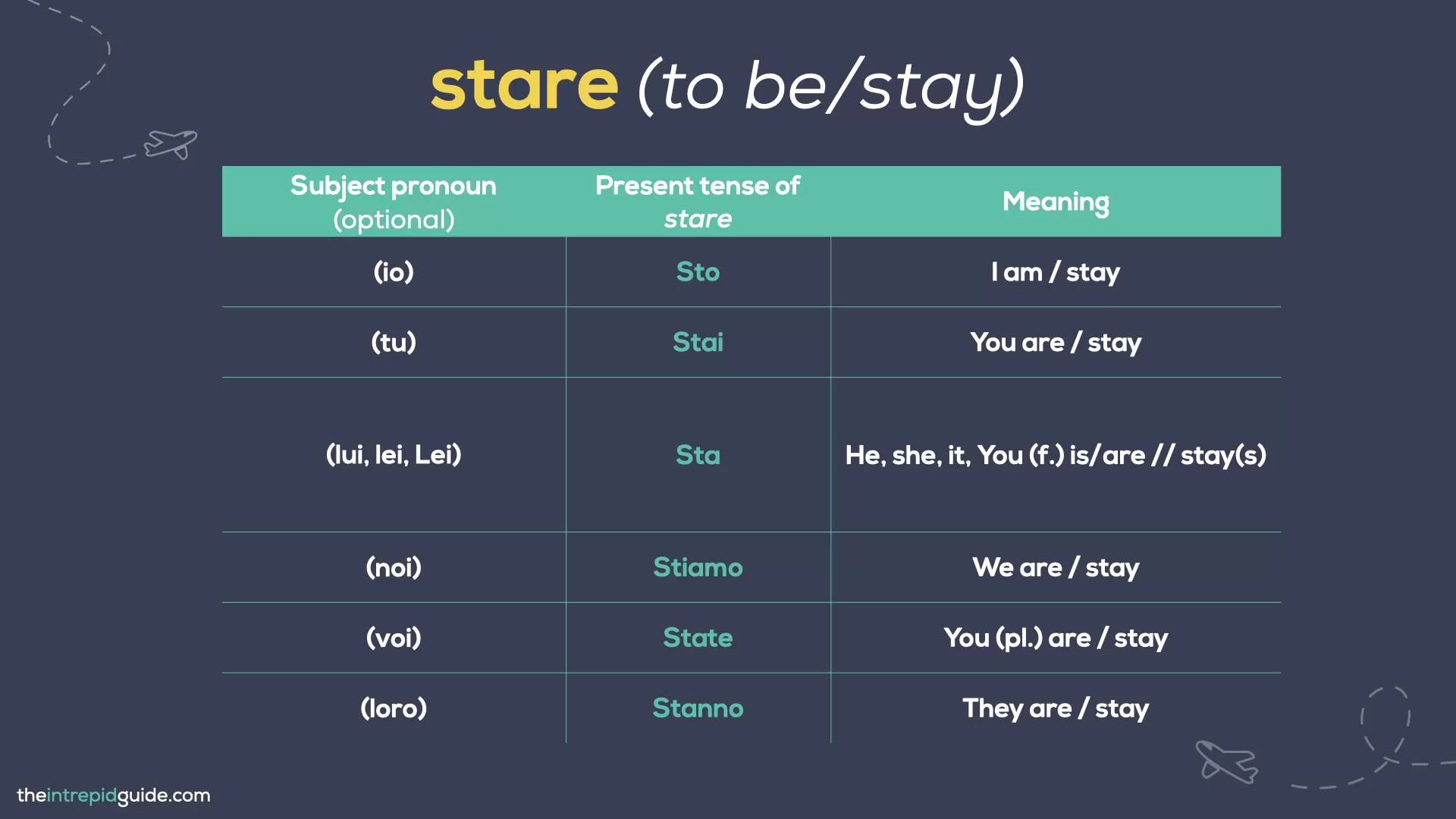 Let’s now take a look at all six cases where the verb stare is used. But before we do that, let’s see how it is conjugated in the present tense.
Let’s now take a look at all six cases where the verb stare is used. But before we do that, let’s see how it is conjugated in the present tense.
| Verb conjugation | English translation | |
|---|---|---|
| (io) | Sto | I am / stay |
| (tu) | Stai | You are / stay |
| (lui, lei, Lei) | Sta | He, she, it, You (f.) is/are // stay(s) |
| (noi) | Stiamo | We are / stay |
| (voi) | State | You (pl.) are / stay |
| (loro) | Stanno | They are / stay |
1. Using the verb STARE to mean ‘to feel’
First of all, stare is used to express a temporary physical and psychological condition, in replacement of the verb sentirsi, ‘to feel’. I’m sure you’re familiar with the expressions: Come stai? – Sto bene/male, which are the first things students of Italian learn, meaning: ‘How are you? – I’m well/not well’. Other than being conventional ways of greeting some, the question come stai? or come sta? (formal) can be asked to genuinely enquire about the state of health of someone. Here, stare can be replaced by sentirsi.
Look at the following example:
- Come sta/si sente Giuseppe? L’ultima volta che l’ho visto non stava/si sentiva bene. (How is Giuseppe? Last time I saw him, he wasn’t feeling well.)
Unlike essere, stare is only used with an adverb (and not a noun or adjective!) when it means ‘to feel’, e.g. stare bene/male/così così (to be well/not well/so so).
2. Using the verb STARE to mean ‘staying’
Another use of stare is to indicate the location or position of something, like the verb ‘to stay’ in English. In this case, it could be replaced by the verb restare. For example:
- Questa sera stiamo/restiamo a casa. (Tonight we’re staying at home.)
- Stiamo/Restiamo in questo resort per una settimana. (We’re staying at this resort for a week.)
3. The verb STARE is used to indicate temporary behaviors
Another case in which stare is used, is to describe temporary conditions or behaviors, like in the expressions:
- Stare zitti / in silenzio (to be quiet)
- Stare in ansia (to be anxious)
- Stare calmi (to keep calm)
Attenzione! Here, the verb stare can be replaced with essere. The difference is that while essere focuses more on a quality of the subject, stare expresses more intentionality and it’s often used as an order or command (e.g. stai calmo!, ‘stay calm!’).
4. The verb STARE is used with the pronoun CI
Like esserci, starci can also have more than one meaning. We use it to say that we agree on something, that we’re in, or that we’re up/down for doing something. Look at the following examples:
- Andiamo al cinema stasera? – Ci sto! (Shall we go to the cinema tonight? – I’m up for that!)
- Ci stai per una partita a poker? (Are you in for a game of poker?)
Starci also means to get in, to fit, as in ‘to have enough space’. For example:
- Questo portafoglio non ci sta nella mia borsetta. (This wallet doesn’t fit in my handbag.)
- Non ci stiamo tutti in macchina. (We can’t all get in the car.)
5. Phrases with STARE
Stare is also used in some particular expressions with a specific meaning, for example:
Stare + gerund
This indicates an action in progress, such as:
- In questo momento, Paola sta leggendo e Teresa sta facendo la doccia. (In this moment, Paola is reading and Teresa is taking a shower.)
Stare per + infinitive
This describes what is just about to happen in the next few moments or a short amount of time, for example:
- L’aereo sta per decollare. (The plane is about to take off.)
- Sto per chiamare Elena (I’m about to call Elena.)
6. Common idiomatic phrases with STARE
- Stare + indirect pronoun in the weak form (for example mi sta, ti sta, gli sta, ecc..): it’s mostly used with clothes and it means ‘to look (good, bad, etc.) on someone’. For example: Come mi sta questa gonna? – Ti sta benissimo! (How does this skirt look on me? – It looks amazing on you!).
- Stare ai fatti/ai dati means to stay focused on facts/data. For example: Non voglio ascoltare le tue strane ipotesi sull’accaduto, preferisco stare ai fatti. (I don’t want to listen to your weird hypothesis on what happened, I prefer to stick to the facts.)
Conclusion
Based on what we’ve seen so far, the expression sono stato/a can mean both ‘I was’ and ‘I stayed’. It all depends on the context and the other elements of the sentence!
Hai capito? (Do you understand?) Now test yourself by taking my free quiz below. Read the sentences and choose which verb is more appropriate to use essere or stare. Share your score in the comments!
 Are you a beginner or an intermediate Italian learner? Got a trip coming up or want to communicate with your Italian partner or relatives in Italian? Learn Italian with my unique 80/20 method
Are you a beginner or an intermediate Italian learner? Got a trip coming up or want to communicate with your Italian partner or relatives in Italian? Learn Italian with my unique 80/20 method
Registrations are now open to join Intrepid Italian, my new series of online video courses that use my unique 80/20 method. You’ll go from a shy, confused beginner to a proficient and confident intermediate speaker, with me as your trusty guide.
You’ll finally be able to connect with your Italian partner, speak to your relatives and enjoy authentic travel experiences in Italy like you’ve always dreamed of, and so much more.
As a native English speaker who learned Italian as an adult, I know what it’s like to feel hopeless and lack the confidence to speak. I know what it’s like to start from scratch and to even go back to absolute basics and learn what a verb is!
Intrepid Italian was created with YOU in mind. I use my working knowledge of the English language to help you get into the ‘Italian mindset’ so you can avoid the common pitfalls and errors English speakers make – because I made them once too! I break everything down in such a way that it ‘clicks’ and just makes sense.
No matter what your level is, there is an Intrepid Italian course for you, including:
- 🇮🇹 Intrepid Italian for Beginners (A1)
- 🇮🇹 Intrepid Italian for Advanced Beginners (A2)
- 🇮🇹 Intrepid Italian for Intermediates (B1)
You can join 1, 2, or all 3 courses, it’s entirely up to you. The best part is that you have lifetime access so you learn anytime, anywhere and on any device.
As your guide, I walk you through each lesson, step-by-step, using my unique 80/20 method. My approach is different from traditional methods because I teach you the most important 20% of the language right from the beginning so you can start to speak straight away.
Each course includes video lessons, audio exercises, downloadable worksheets, bonus guides, a private support community, and lifetime access all designed to streamline your learning while having fun.
It even comes with my famous “Celebrate with a Spritz Guarantee”. After 30 days of using Intrepid Italian, if you don’t want to celebrate your new-found Italian skills with an Aperol Spritz, you don’t have to pay a penny! Cheers! 🥂
Join Intrepid Italian here and start learning today!
Ci vediamo lì! (See you there!)
Like it? Pin it for later!
Learning Italian? Don’t miss these Italian language guides
- What is your level in Italian? Find out with this FREE quiz!
- What is the best way to learn Italian? Here’s how I did it!
- How to Conjugate Italian Verbs in 3 Simple Steps [Italian for Beginners]
- 15 Italian Words You Should NEVER Mispronounce [& How Not To]
- Italian Numbers: How to Count in Italian From 0 to 1 Billion (Plus PDF Download)
- Master Days of the Week in Italian (7 Simple Memory Hacks)
- How to Order Food & Drinks in Italian [Italian for Beginners]
- Is Italian Hard to Learn? 7 Common Mistakes & How to Avoid Them
- 41 Italian Greetings: How to Say ‘Hello’ in Italian Like a Local
- 11 Effective Hacks That’ll Help You Learn Italian So Much Faster
- Top 14 Italian Words You Should NEVER Say [& What to Use Instead]
- 20 Hilarious Everyday Italian Expressions You Should Use
- Romanesco: 25 Cool Roman Dialect Words You Should Use in Rome
- 10 Reasons Why Learning Italian Will Change Your Life
- How to Learn Italian Before Your Trip
- 10 Italian Expressions Italians Love Saying
- Italian for Beginners | 8 DEADLY Mistakes in Italian (& How to Avoid Them)
- 10 Italian Phrases That Will Instantly Make You Sound more Italian
- Funny Italian Sayings: 26 Food-Related Insults You Won’t Forget
- 15 Romantic Italian Films That’ll Make You Love Italy Even More
- How to Master Common Italian Phrases for Travel (Like a Local!)
Over to you!
Did you find this guide useful? What other verbs do you mix up in Italian? Let me know using the comments section below or join me on social media to start a conversation.
Thanks for reading and I hope you enjoyed this post.
Like what you see? Subscribe using the form below to have all of my posts delivered directly to your email.

